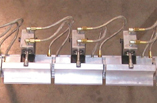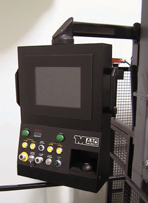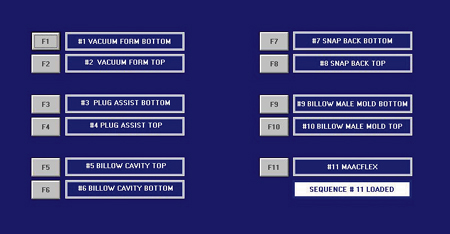|
THERMOFORMING: Cut Sheet Thermoforming
Reduce your downtime;
increase your up-time –
with NEW TECHNOLOGY
and Quick Change Features!
As economic times change,
competition increases,
customers demand quicker
deliveries, or end-users push
for better products and pricing,
thermoformers are being forced
to step up to the next level. Our
industry is changing rapidly,
moving towards higher levels of
sophistication. Whether you are
a small or larger company, an OEM, a custom former or
run your own proprietary products, there are several ways
to reduce your downtime and start gaining efficiencies
with all the new advancements and innovations in thermoforming
machinery.
From quicker clampframe and mold changes to elaborate
machine controls, thermoformers who are set up
most effectively are proving to be the most profitable.
Today’s thermoformers need to set their goals much higher;
reduce mold changeover to
fewer than 15 minutes, reduce
clampframe changeovers to
fewer than 5 minutes (per station),
and look to change all
machine parameters in seconds!
Clampframe Changeover
Clampframe changeover has
been one of the leading factors
causing machine downtime. A routine clampframe change
can take up to 4 hours depending on how many stations
a machine has. A clampframe change typically consists of
replacing the short clampframe segments for every different
sheet width. Not only do thermoformers have to buy
all these different size short frames, they must store and
maintain them. One of the newest items available,
Adjustable Clampframes, have been the single hottest
items to hit the machinery market. You no longer need to store and replace different lengths of clampframe
for the diverse sheet sizes required.
 Adjustable
clampframes offer the ability to vary the length
of the clampframes without having to add or
remove clampframe sections from the machine
and with no tools required. Not only can you
change these frames in under 5 minutes, but you
can also document the position of these
clampframes and easily return them to the exact
position the next time the product is run. This
would also require a repeatable mold position.
Adjustable clampframes are continually proving
to save anywhere from 1 to 3 hours of downtime,
(per mold changeover) depending on what type
of machinery or how many stations the equipment
has.
Adjustable
clampframes offer the ability to vary the length
of the clampframes without having to add or
remove clampframe sections from the machine
and with no tools required. Not only can you
change these frames in under 5 minutes, but you
can also document the position of these
clampframes and easily return them to the exact
position the next time the product is run. This
would also require a repeatable mold position.
Adjustable clampframes are continually proving
to save anywhere from 1 to 3 hours of downtime,
(per mold changeover) depending on what type
of machinery or how many stations the equipment
has.
In addition to speeding up clampframe
changeover time; look to reduce your sheet
sizes. Some of the older or poorly designed
clampframe systems require up to 2” of material
to be clamped in their frames. This should be
kept to a minimum of no more than a 1/2” of
material per side.
Mold Changeover
Mold changeovers are another one of the
leading factors causing machine downtime.
Since most molds are unique, are built by different
suppliers, or are moved from company to
company, most thermoformers end up with a
large quantity of different mold bases and mold
configurations. The key to quick mold change is
to make all design factors on each mold common
to each other, such as: utility location,
mold base heights and general mold base construction.
If this is not possible or cost-effective
then consider using a stand alone – common
mold base.
With uncommon mold bases, the use of steel
plates with precisely spaced bolt patterns or aluminum
plates with T-slots have been most popular.
Molds are then secured using either a hold
down fixture or simply by bolting the mold base
to the platen. This may still be the most versatile
system for some thermoformers.
With a stand alone – common mold base,
thermoformers can utilize several mold bases
or just two mold bases. The expense of
changing all your mold bases may not be
cost-effective, but the use of only two keeps your expenses minimal. This allows one mold (attached to the 1st
mold base) to be run in production while another mold is being
secured to the 2nd mold base outside the machine. This can even
be taken a step further by having all of the utilities connected
outside the machine.
The actual design of the mold base is unlimited but needs to be
designed with maximum flexibility in mind. With a common mold
base you can then look to automate the changeover process even
further. You can use scales, locating pins, locating cones or back
stops to consistently locate the mold base to the platen. You can use
hand clamps or automatic clamps controlled through the machine to
secure your base down to the platen.
Of course this is easier said than done, and other factors must be
considered, but it usually is just a matter of discussing a few different approaches to determine what best fits your company. The
technology is here and has been taken as far as fully
automating mold changeovers. As a result with any of these
systems you will start realizing more machine up-time.
Adjustable Lift Table Tops
On most high sheet line rotary machines and/or
machines with lift tables, clients need to make different
size boxes or use boards to assist holding and aligning
sheet before it is loaded into the clampframe. Once these
boxes and/or boards are not being used they must be
stored away for future use. This has created the development
of an adjustable lift tabletop which is custom built
and mounted to the lift table. This allows quicker set-ups
by avoiding the need to replace tabletops for every different
sheet size. These tabletops feature four-way adjustments
via clamping handle levers. No tools are required.
This allows changing of the table top in seconds.
Machine Control Changeover
 Machine controls should be
looked at closely, as they are one
of the most powerful components
associated with quick changeover.
Machines with simple controls are
limited, and typically more time
consuming which causes inefficiencies.
Machines with elaborate controls
are able to be set up much
quicker, offering maximum flexibility
and maximum efficiencies.
Machine controls should be
looked at closely, as they are one
of the most powerful components
associated with quick changeover.
Machines with simple controls are
limited, and typically more time
consuming which causes inefficiencies.
Machines with elaborate controls
are able to be set up much
quicker, offering maximum flexibility
and maximum efficiencies.
Computerized controls offer numerous benefits.
Replacing relays and timers, manual buttons and switches
with flat panel touch screen interfaces and innovative software
allows thermoformers the ability to change every
machine parameter within seconds. This eliminates the
manual process of setting up different machine sequences,
adjusting limit switches, opening and closing valves, setting
oven heat configurations and even reading job setup
sheets. Below is a brief description of the many items now
being fully controlled and automated through new technology
and new control systems:
Limited or Basic Controls
Less process control, higher scrap rates, no reliability,
no repeatability, longer setups.
Elaborate Controls
Most process control, less scrap, repeatability, quicker
setups.
Preprogrammed Forming Techniques are absolutely
necessary. Instead of having to physically program the
entire sequence of the machine during the initial setup
(which can take a great deal of time), your machine
should have pre-programmed forming techniques. This
means setup personnel can choose from a selection of
different preprogrammed sequences, eliminating the
need to program all functions of an entire machine
sequence every time the job is run.

Preprogrammed
forming techniques cover over 90% of the thermoforming
work today and only take seconds to set up. In addition,
the newer control systems offer the ability to modify
these preprogrammed forming techniques to create
your own proprietary methods if a challenging application
is introduced.
Platen positioning and motor speeds are now controlled
through the control system. Gone are the time-consuming
days of manually adjusting collars or limit switches. Today
motor driven platens are typically equipped with encoders
for fast setups, repeatable speeds and precise positioning.
The encoders are then interfaced into the control system
with real time graphic emulation of platen movement displayed
on screen. The platen settings are then stored in
the controller with each job for future recall. Although this
has been available for quite some time, it is being taken
further every year. Encoder driven platens no longer
require homing or zeroing and the machine may be turned
off without losing platen home position.
Vacuum and air valve positioning typically requires
setup personnel to manually adjust vacuum and/or air ball
valve settings. On more complex products these settings
can be crucial to forming an acceptable part. Too much
vacuum can cause improper material distribution on certain
applications and not enough vacuum can cause the
material to not fully form to the shape of the mold. New
technology now offers computer controlled valves, which
provide maximum consistency and repeatability with positioning
increments from 0-99%. With computer controlled
valves, all vacuum and air valve settings are entered into
the control system and saved with each job for future
recall. By saving and recalling valve positioning with every
job, computerized valves eliminate the manual guess work
of finding the correct vacuum and/or air valve openings,
which in some cases can eliminate hours of fine tuning.
Automatic lance adjustments are also completely programmable
through the control system. If pressure forming
or twin sheet forming is your company’s focus, adjusting
the lances (or bayonets) adds on to your setup time.
Typical pressure forming applications require setup personnel
to manually adjust the bayonets when the mold
lock-up heights change. This can be a lengthy process
since setup personnel must physically measure and position
anywhere from 4-12 lances (or bayonets) for each setup.
There is also room for error when manually adjusting,
as each bayonet’s positioning should be exactly the same
or damage can be caused to the machine and/or molds.
Automatic lance adjustment was created to eliminate the
manual process of setting up the lances, which on some
machines can take up to 4 hours. New pressure forming
machinery fitted with automatic lance (or bayonet) adjustment
assure: repeatable, accurate and fast changeovers
within seconds. The lock up height is automatically set by
finalizing both platen positions, simply activate and the
lances will self adjust. The positioning is then stored and
saved for each job for future recall.
In addition to faster changeovers, new technology is
offering even more features to gain efficiencies. Between
elaborate diagnostic systems and automatic lubrication
systems, machinery manufacturers are continually looking
to add to the thermoformer’s bottom line. Diagnostic systems
are eliminating lengthy trouble shooting procedures
and automatic lubrication systems are reducing the maintenance
required and increasing the life of the machinery.
As machines get smarter, faster and are equipped with
these types of quick change features, thermoformers who
lag behind in technology will find it much harder to compete
and be successful. Many thermoformers are acquiring all of
this technology in their new machinery. Some have even
found they can meet their increased production requirements
with these new technologies after getting rid of older
machinery. Meaning, one new machine has replaced the
need and production requirements of two older machines.
Clients who are investing in this machinery are gaining
efficiencies; they are making better products faster, more
repeatable, reducing scrap rates, reducing maintenance,
reducing personnel and of course adding to their bottom
line! In years to come those who do not start adapting new
technology will no longer be competitive, as today’s thermoformers
are taking large steps to leap ahead in technology.
Learn and investigate, start planning to eliminate
all the old mind sets and inefficiencies. As labor rates
increase and material rates increase, the market will continue
changing. Ask yourself “How will I compete?”
Written by Michael P. Alongi, Sales Director for MAAC
Machinery Corp., manufacturers of a wide range of cutsheet
thermoforming machinery.
For more information, contact MAAC Machinery Corp., 590 Tower Blvd.,
Carol Stream, IL 60188, 630-665-1700, Fax: 630-665-
7799, E-mail: sales@maacmachinery.com, Web:
www.maacmachinery.com.
|